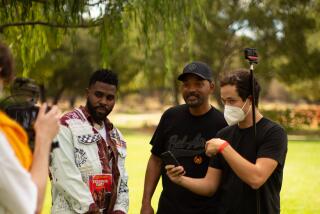I want my Fuse TV
- Share via
NEW YORK — It’s early evening in a midtown Manhattan studio, and several dozen teenagers have assembled for music television’s daily ritual: a broadcast of their top-voted music videos.
The lucky fans who make up the studio audience are sprinkled about the set like pieces of decor. Unlucky ones stand on the street in gloves and scarves, peering through the studio’s enormous windows, angling for screen time or a glimpse of today’s musical guest, rock group Brand New. Two perky VJs banter with the band, chitchat with the audience and occasionally announce videos. Applause abounds.
“TRL”?
No -- this is “IMX.”
To translate for the pre-music-video generation, “TRL” is “Total Request Live,” MTV’s after-school video countdown, which regularly attracts gushing fans to the station’s flagship studio in Times Square.
“IMX” is “Interactive Music Xchange,” a relatively new program on the upstart Fuse TV, which likes to think of itself as the anti-MTV.
Like Fuse itself, “IMX” -- which counts down videos but also allows viewers to “buy” and “trade” them via the channel’s website -- is subtly distinct from MTV. Its VJs are as cheery as onetime “TRL” personality Carson Daly but much cheekier, quick to render judgment -- sometimes harsh -- on the videos they air.
“TRL,” lording over Times Square, welcomes A-list celebrity guests; “IMX,” across the street from Madison Square Garden, welcomes a fair share of acts -- including Thrice and Switchfoot -- unlikely to headline that arena.
And while “TRL’s” studio sits stories above the street and the fans gathered there, “IMX’s” is ground-level and fan-friendly.
“You can see everything, and they sometimes let us in,” says one “IMX” fan, 17-year-old Alexandra Rylkiewicz, who’s carrying a guitar case and has come to ogle Brand New. “ ‘IMX’ is so much better than ‘TRL,’ ” she gushes. “They actually play videos -- whole videos.”
It’s a retro concept, one that Fuse is banking on: a music video channel made from the ingredient MTV has long relegated to side dish -- videos themselves. Not simply high-gloss, high-cost extravaganzas but quirky, low-budget efforts such as Electric Six’s “Danger! High Voltage,” whose idea of special effects is well-placed light bulbs.
“We’re the first alternative voice and choice for music lovers,” says Mark Juris, CEO of Fuse, formerly the MuchMusic channel. “And we’ve democratized music by giving viewers control.”
Peddling itself as the antidote to music television monopoly -- MTV, MTV2 and VH1 are owned by Viacom -- Fuse was launched eight months ago and is in 34 million homes nationally. Owned by Cablevision, it has an interactive website and predominantly viewer-determined programming -- both of which, Juris says, keep closer tabs on the music-loving masses than even MTV2 does.
The latter, which reaches 48.9 million homes and is more video-centric than MTV, is still named for the institution that it’s an alternative to.
“Because we’re newer and smaller and more nimble, we can respond quickly to new things and new music,” says Juris, adding that when it comes to musical trends, his “truly interactive” network is determined to remain on top of the “radical fringe.”
Fuse boasts a truckload of sassy slogans: “More music, less crappy TV”; “Like porn, but with music instead of sex”; “No whiny kids living together, no ridiculous tours of other people’s homes.”
This last line, a jab at MTV’s “Real World” and “Cribs” shows, is ammunition in an ongoing PR battle between the two networks that has been colorfully covered on high-profile media gossip pages. The first shot was fired in May, when Fuse, generating its first bit of buzz, promoted its launch with cups reading “where’s the M in Emptee-vee?”
Fuse found its billboard model in the ever-earnest Sally Struthers. “Right now, a music video is being neglected,” read the ads, which parodied her “Save the Children” campaign and celebrated Fuse for “saving the music video.”
The MTV formula is tough to avoid
But peruse Fuse’s programming and you’ll spot an irony: In its effort to unseat the cultural Goliath that is MTV, Fuse ends up proving how potent this adversary is. For one, saving music videos means borrowing a page from the entity that did away with them in the first place. Like today’s MTV -- and unlike yesterday’s, in which a mishmash of sounds were played back to back -- Fuse often offers videos in neat, generic packages: “Uranium,” a metal show; “¡Marcha!,” an English-language weekly Latin series, or “Authentic Hip-Hop,” a melange of indie and pop rap.
There are videos galore, but true to the MTV formula there is also nonvideo programming. “Kung Faux,” a collaboration with Tommy Boy Records, gives kung fu flicks a hip-hop makeover (and preceded “Volcano,” MTV’s recent experiment with hip-hop-dubbed Korean film). “Behind the Music That Sucks” pokes fun at the VH1 program that treats celebrity biography with sincere gravitas. The forthcoming “4Play” will merge extreme sports and music video.
As for Fuse’s crop of VJs, they may be a bit edgier than MTV’s ever-pleasant hosts, but they’re equally teen- (and screen-) friendly: Fuse’s Marianela Pereyra was named FHM magazine’s “hottest VJ,” while all-American Steven Smith was once on VH1. Breaking from the MTV formula, it seems, is easier said than done.
Of course, Fuse does differentiate itself via its bread and butter: that truly eclectic video rotation, which offers equal spins to all and is voted on by visitors to the website (www.Fuse.tv).
Necessity fuels some of the mix. The channel’s access to new videos is somewhat restricted by MTV’s exclusivity deals with the major labels for a percentage of their video output, so Fuse focuses on up-and-coming acts such as a Simple Plan. The group was all but unknown when it performed live at Fuse headquarters and won the support of the staff. It’s now an MTV favorite, and Fuse is sponsoring its coming tour.
“We like to think that if a video is good television, we’re open to airing it,” says Janice Unterweiser, director of programming and scheduling at Fuse. “And our viewers are the ones who really determine what stays and goes.”
But in the end, even Fuse’s anti-establishment, pro-video effort is homage to the three-lettered network that gave music videos an outlet and thus essentially invented the genre. Remember the pre-video days, when music was an aural experience, not an image-centered visual one? Thankfully, they might be back, now that the Internet and satellite radio reestablishing music itself as the heart of the music scene.
Fuse, for all its irreverent flash, is conservative to the core. As it sets out -- hand in hand with Sally Struthers -- to “save the music video,” it never stops to ask: Why bother?
More to Read
The biggest entertainment stories
Get our big stories about Hollywood, film, television, music, arts, culture and more right in your inbox as soon as they publish.
You may occasionally receive promotional content from the Los Angeles Times.










